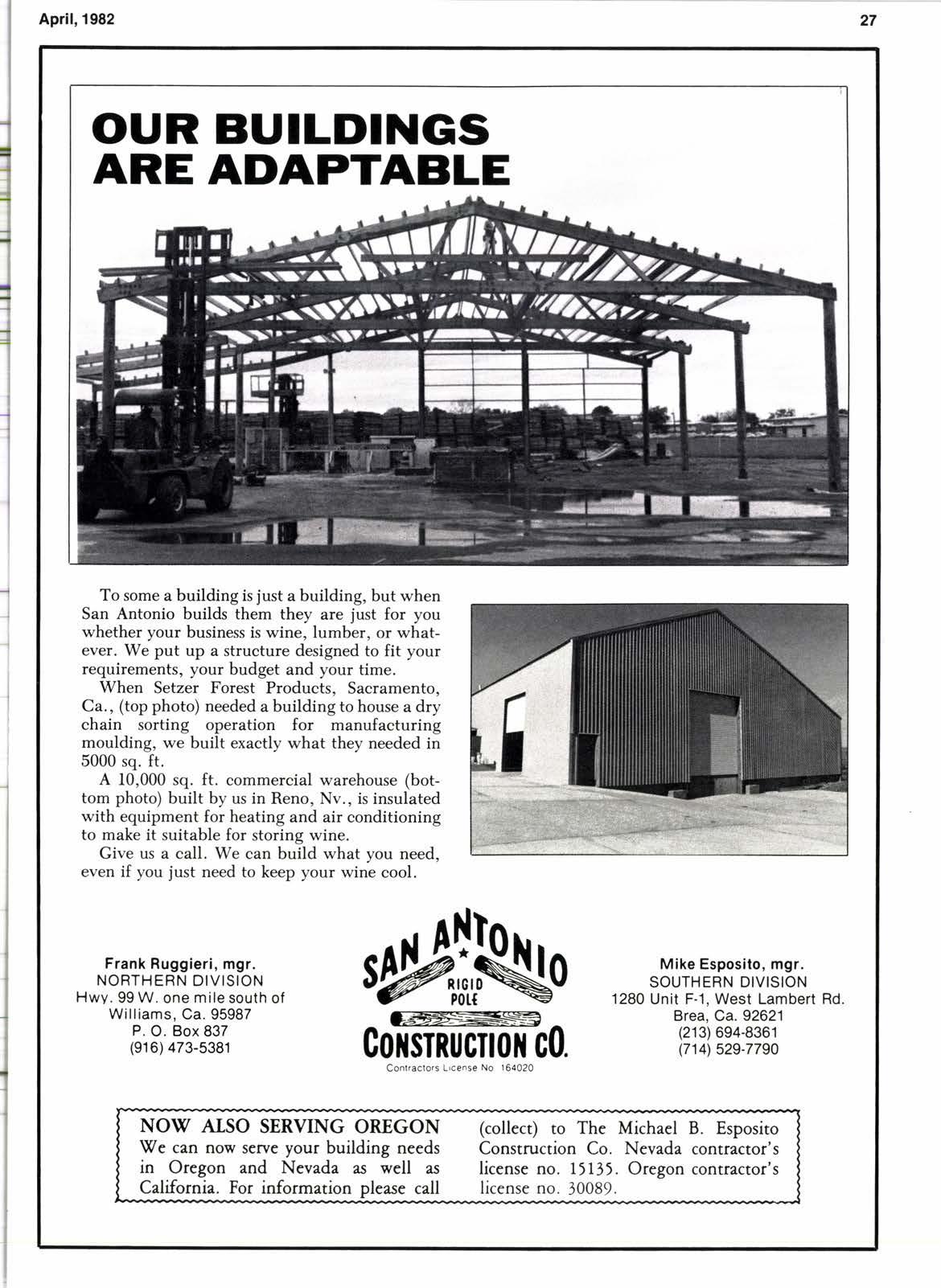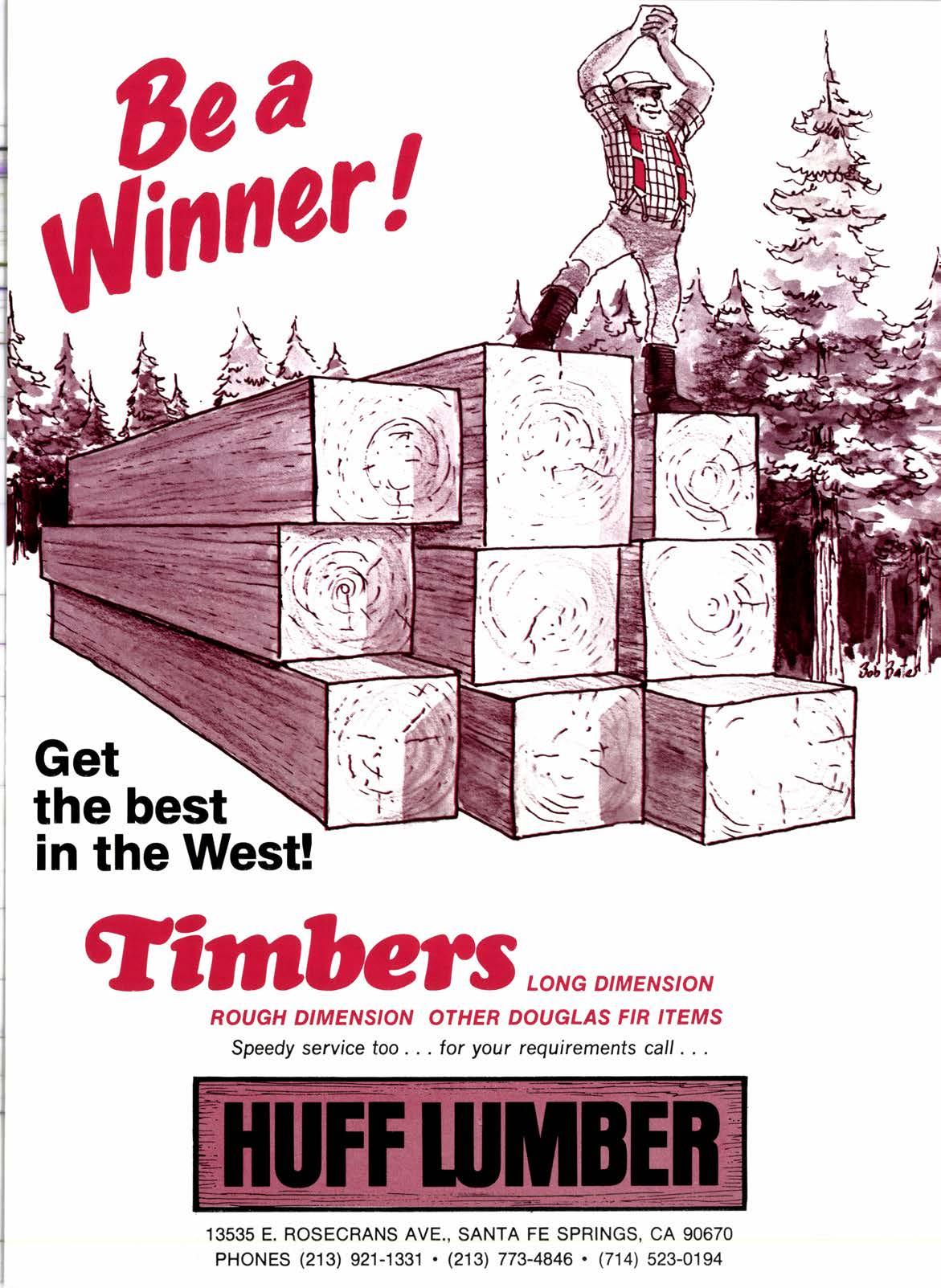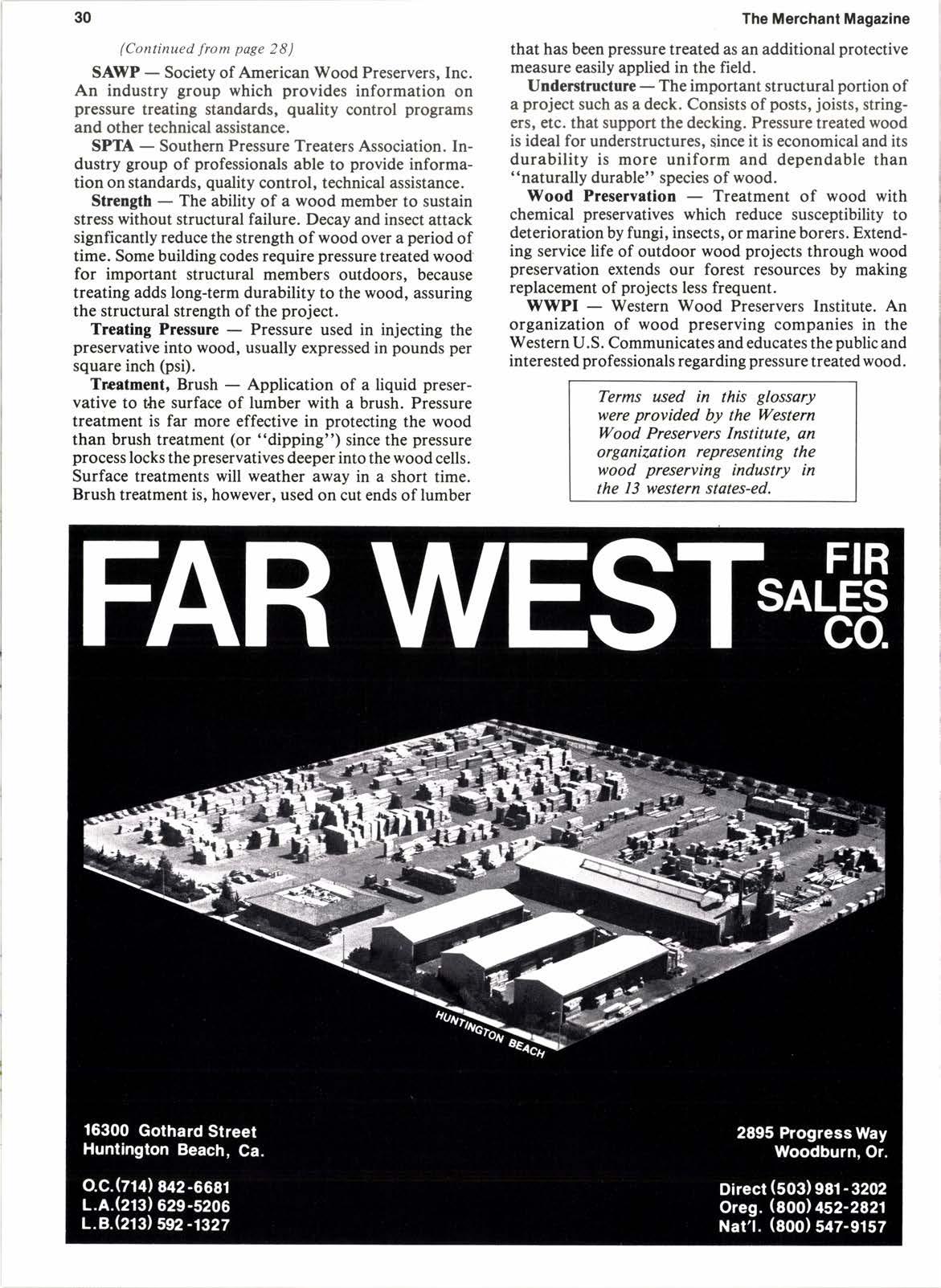
4 minute read
OUR BUILDTNGS ARE ADAPTABLE
To some a building is just a building, but when San Antonio builds them they are just for you whether your business is wine, lumber, or whatever. We put up a structure designed to fit your requirements, your budget and your time.
When Setzer Forest Products, Sacramento, Ca., (top photo) needed a building to house a dry chain sorting operation for manufacturing moulding, we built exactly what they needed in 5000 sq. ft.
A 10,000 sq. ft. commercial warehouse (bottom photo) built by us in Reno, Nv., is insulated with equipment for heating and air conditioning to make it suitable for storing wine.
Give us a call. We can build what you need, even if you just need to keep your wine cool.
Frank Ruggieri, mgr.
NORTHERN DIVISION
Hwy. 99 W. one mile south of Williams, Ca.95987
P. O. Box 837
(916) 473-5381
Now Aiso Serving Oregon
We can now serve your building needs in Oregon and Nevada as well as California. For information plcase call
1280 Unit F-1, West Lambert Rd. Brea, Ca. 92621
(213)694-8361
(714\ 529-7790
(collect) to The Michael B. Esposito Construction Co. Nevada conffactor's license no. 15135. Oregon conilactor's license no. 30089.
PRESSURE TREATED ABCs
(Continued from page 11) content. Serious decay can occur in untreated wood when the moisture content is above the 30q0 fiber saturation point. Lumber is said to be reasonably protected from decay if it is maintained at a moisture content of l99o or less. This is essentially "dry" lumber.
PoleRound wood or log, generally used as utility poles or for house foundations. Most often pressure treated for durability.
Penetration - The depth to which preservative chemicals enter the wood.
PentaSee Preservative
Preservative, Oil-borneA wood preservative that is introduced into wood in the form of a solution in oil.
Preservative, WoodIncludes all chemicals or combinations of chemicals that will protect wood against deterioration from decay, insects, marine borers, fire, weathering, absorption of water and chemical action. Some commonly used preservative chemicals include: ACAammoniacal copper arsenite; ACCacid copper chromate; Creosotetar distillate; PentaPentachlorophenol dissolved in a hydrocarbon solvent; CCA - Chromated copper arsenate. These chemicals will leave wood with a greenish tint, a natural brown color, or, in the case of creosote, a dark brown to black color.

Pressure TreatmentProcess of treating wood in a closed container where preservative or fire retardant is forced into the wood under pressure. Pressure is generally preceded or followed by vacuum.
Quality ControlIn pressure treating, the AWPB administers a quality control and inspection program that includes a quality wood-marking program to assure that treated wood will perform well in the use for which it was intended. Basically, lumber is treated to two different preservative retention and penetration levels: one for inground use (LP-22 mark) and one for lumber used above the ground (LP-2 mark).
RetortSee Cylinder, Treating.
RetentionSee Assay.
RotSee Decay.
SapwoodWood of pale color near the outside of the log. Under most conditions, the sapwood is more susceptible to decay than heartwood, and a log usually has a higher percentage of sapwood than heartwood. No species of wood has sapwood that is naturally resistant to decay and insects.
SersoningAlso known as "Drying." The removal of moisture from green wood to improve its serviceability. Can be accomplished by either air-drying or kilndrying. Seasoned wood will shrink less than unseasoned wood.
ShrinkageAs wood loses moisture, it shrinks. Essentially, wood does not shrink when it is above the fiber saturation point. Wood shrinks most in the direction of the annual growth rings (tangentially) and shrinks only about half as much across the rings (radially). It shrinks only slightly along the grain (longitudinally). This dimensional instability of wood below the fiber saturation point can distort the shape of wood pieces depending on the curvature of the annual rings. Kiln-drying minimizes the distortions that shrinkage can cause.
(Please turn to page 30)

(Continued from page 28)

SAWP - Society of American Wood Preservers, Inc. An industry group which provides information on pressure treating standards, quality control programs and other technical assistance.
SPTASouthern Pressure Treaters Association. Industry group of professionals able to provide information on standards, quality control, technical assistance.
StrengthThe ability of a wood member to sustain stress without structural failure. Decay and insect attack signficantly reduce the strength of wood over a period of time. Some building codes require pressure treated wood for important structural members outdoors, because treating adds long-term durability to the wood, assuring the structural strength ofthe project.
Treating PressurePressure used in injecting the preservative into wood, usually expressed in pounds per square inch (psi).
Treltment, Brush - Application of a liquid preservative to the surface of lumber with a brush. Pressure treatment is far more effective in protecting the wood than brush treatment (or "dipping") since the pressure process locks the preservatives deeper into the wood cells. Surface treatments will weather away in a short time. Brush treatment is, however, used on cut ends of lumber that has been pressure treated as an additional protective measure easily applied in the field. lVood Preservation
UnderstructureThe important structural portion of a project such as a deck. Consists ofposts, joists, stringers, etc. that support the decking. Pressure treated wood is ideal for understructures, since it is economical and its durabilityis more uniform and dependable than "naturally durable" species of wood.
Treatment of wood with chemical preservatives which reduce susceptibility to deterioration by fungi, insects, or marine borers. Extending service life of outdoor wood projects through wood preservation extends our forest resources by making replacement of projects less frequent.
WWPIWestern Wood Preservers Institute. An organization of wood preserving companies in the Western U.S. Communicates and educates the public and interested professionals regarding pressure treated wood.
Terms used in this glossary were provided by the Western Wood Preservers Institute, an organization representing the wood preserving industry in the l3 western states-ed.









